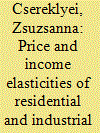| Srl | Item |
| 1 |
ID:
191284


|
|
|
|
|
| Summary/Abstract |
In this paper we investigate the relationship between increasing shares of renewable generation and the wholesale market revenues of coal-fired generating units in Australia's National Electricity Market (NEM). Renewable generation may influence coal generator revenues both through decreased spot market prices and reduced dispatch allocation. We use autoregressive distributed lag (ARDL) models on a high-frequency (30-min) panel dataset between July 2017 and June 2021. We find that a one MWh increase in wind and solar generation each is associated with decreases in coal generator revenues of 0.0062–0.0083 and 0.0041 to 0.0054 AUD2012 respectively, per megawatt of installed coal-fired generating capacity. These results can inform managerial and policy decisions regarding the likelihood of more premature coal plant exits in the coming decades.
|
|
|
|
|
|
|
|
|
|
|
|
|
|
|
|
| 2 |
ID:
150869


|
|
|
|
|
| Summary/Abstract |
The profitability of nuclear power plant investment is largely determined by the construction duration, which directly impacts discounted cash flows, debt and interest payments, as well as variable costs, such as labor. This paper analyzes the key drivers of construction duration using survival models. We focus especially on the strategic expectation formation of private and public utilities engaging in such highly risky megaprojects. Using a balanced dataset of explanatory variables and the IAEA/PRIS dataset of reactor construction starts between 1950 and 2013 we find that the expectation of rising oil prices and higher economic growth, along with the higher per capita GDP of a country tend to reduce the time needed to grid connection. We also identify the reactor models with the fastest construction duration.
|
|
|
|
|
|
|
|
|
|
|
|
|
|
|
|
| 3 |
ID:
166735


|
|
|
|
|
| Summary/Abstract |
Our paper investigates the effect of wind and utility-scale solar electricity generation on wholesale electricity prices in Australia over 2010–2018. We use both high frequency (30-min) and daily datasets for the Australian National Electricity Market (NEM). We estimate autoregressive distributed lag models (ARDL) to decompose the merit order effect of wind and utility-scale solar PV generation over time and across states. We find that an extra GW of dispatched wind capacity decreases the wholesale electricity price by 11 AUD/MWh at the time of generation, while solar capacity by 14 AUD/MWh. The daily merit order effect is lower. We show that the wind merit order effect has been increasing as a function of dispatched wind capacity over time. Despite of this, wholesale electricity prices in Australia have been increasing, predominantly driven by the increase in natural gas prices. Our findings further strengthen the evidence of the merit order effect of renewable energy sources, with important implications for the current energy policy debate in Australia.
|
|
|
|
|
|
|
|
|
|
|
|
|
|
|
|
| 4 |
ID:
171368


|
|
|
|
|
| Summary/Abstract |
This study examines the short- and long-run price and income elasticities of residential and industrial electricity demand in the European Union between 1996 and 2016. Instrumental variable models using the between estimator, as well as dynamic panel models are employed to present robust estimates, and to assess the impact of different methodologies on the reported elasticities. The long-run price elasticity of residential electricity consumption is estimated between −0.53 and −0.56. These elasticities are more inelastic than that of industrial electricity use, which is reported between −0.75 and −1.01. The choice of different econometric methodologies has only moderate impact on the estimates. While long-run residential income elasticity estimates are moderately inelastic and estimated around 0.61, industrial electricity use tends to be closely tied to income, with elasticities between 0.76 and 1.08. Electricity demand in all sectors is highly price and income inelastic in the short run. Additionally, population density, temperatures, and policy measures also influence sectoral electricity use. The above estimates can aid the design of European energy and environmental policy.
|
|
|
|
|
|
|
|
|
|
|
|
|
|
|
|